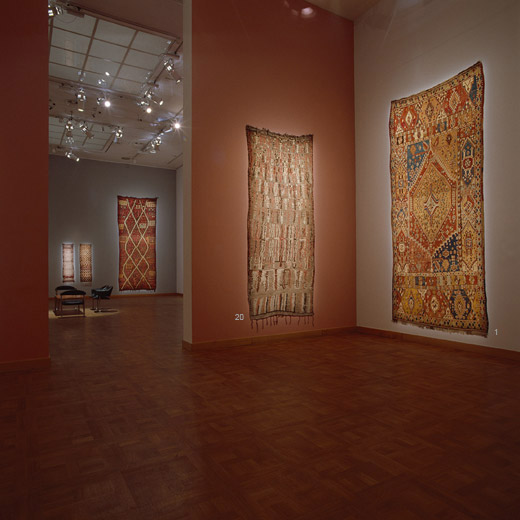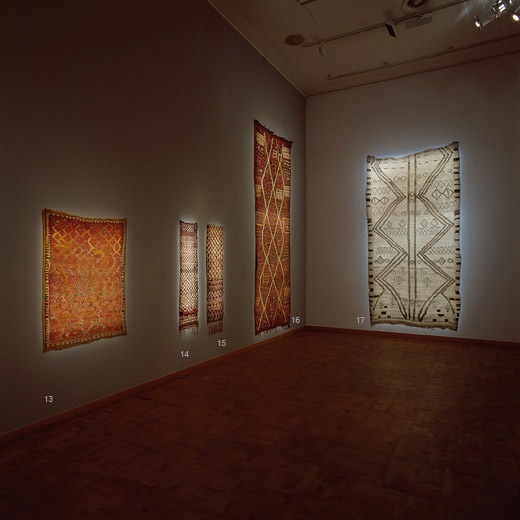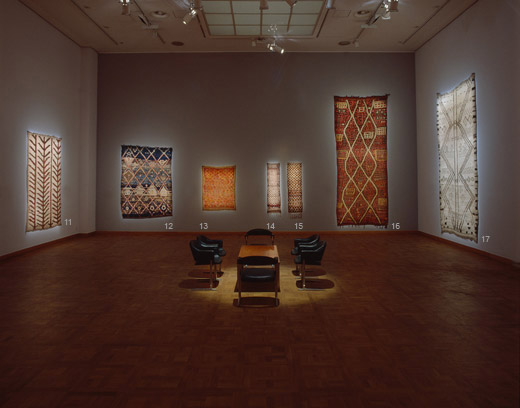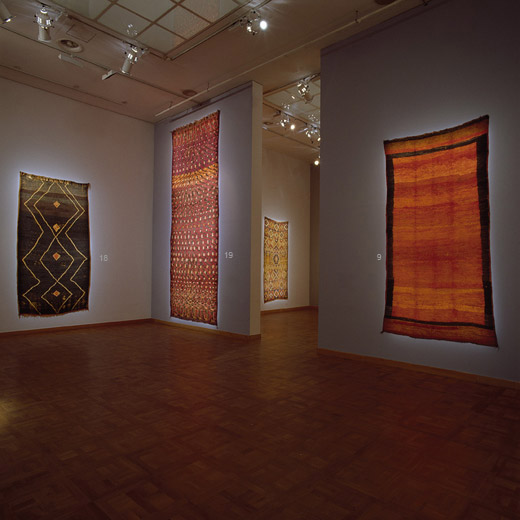| Beauté Sauvage II | |||||
|
an exhibition of Moroccan Berber carpets from European private collections organized by Gebhart Blazek at the BA – CA Kunstforum, Vienna from 10 th of July until 3rd of August 2003.
Four main subjects were drawn out along loose threads: A Rabat carpet from the beginning of the 19 th century (1) and two Ait Ouaouzguite carpets from ca. 1850 - or before - (2+3) bear witness to an early relation between the urban weaving centres of Rabat and Salé and the mountainous regions in the Jebel Siroua area in southern Morocco. In Ait Ouaouzguite weavings from this period the relation to the urban centres is defined much more through a similar colour scheme than through borrowed motifs or field compositions. The square saddle cover (3) in the show contains flatwoven sections in a particular weft substitution technique - a feature which is typical in this form for early Salé hanbels but does not traditionally appear in Ait Ouaouzguite weavings.
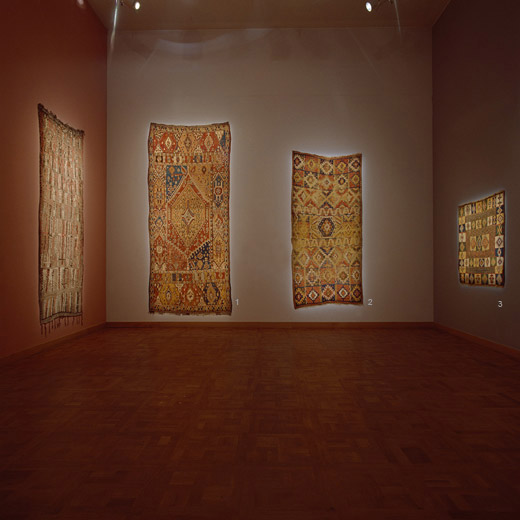 A group of carpets from the High Atlas, the Jebel Siroua region and the Pre-Sahara with checkerboard designs show widespread and individual variations within that highly traditional design concept. Among the Ait Ouaouzguite confederation (namely the Ait Amar) the checkerboard fields tend to be very precisely drawn, most often in black and white (4), while the ones coming from the more south-western Zenaga tend to be more coloured and playful (5, 6 +8).
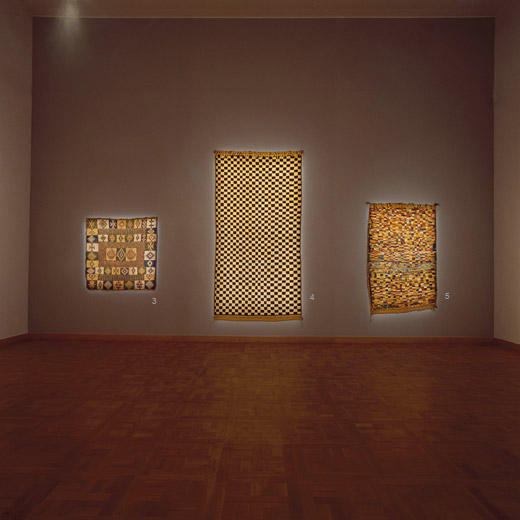 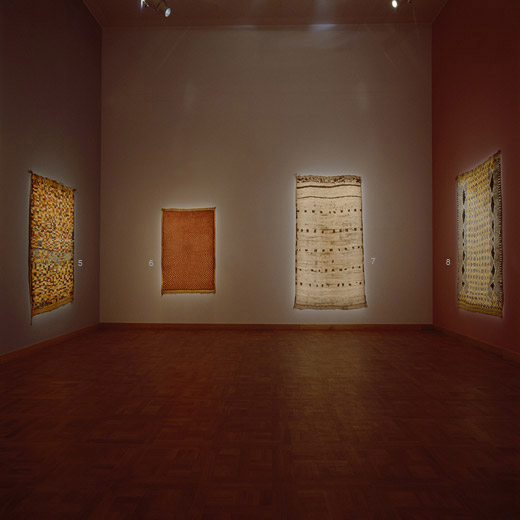 Classical lozenge designs and open field compositions were shown with examples mainly coming from the Middle Atlas and Eastern Morocco, among them an extremely rare carpet of the Zkara (16 - the only other known example is in the property of the Musée Batha, Fès; published in: Amahan / Khatibi: "From Sign to Image, Casablanca 1994) and a most unusual carpet from probably Oulad Setout or Quebdana (19) at the Mediterranean coast hills in Eastern Morocco.
Compared to the common (more or less regular) diamond-grid designs the ones with generous and well-spaced compositions such as vertical arrangements of over-sized diamonds are more rare and obviously the product of the creativity of individual weavers. (1) Rabat carpet, early 19th cent., ca. 380 x 165 cm (12' 8'' x 5' 6''). An outstanding example of an early Rabat carpet with wonderful colors. The design is considered to be typical for the period around 1800. (2) Ait Ouaouzguite (Ait Tamassine or Ait Ouarghada), Jebel Siroua region, southern Morocco, mid 19th cent., ca 310 x 140 cm (10' 4'' x 4' 8''). A very early capet from the Jebel Siroua region bearing whitness in it's colors and layout scheme of a relation between the remote Ait Ouaouzguite region at the northern edge of the Sahara and the urban centers around Rabat and Salé; exhibited at the Musée de Marrakech during ICOC, Marrakech 2001 (3) Ait Ouaouzguite (Ait Tamassine or Ait Ouarghada), Jebel Siroua region, southern Morocco, mid 19th cent., ca 130 x 130 cm (4' 4'' x 4' 4''). Another whitness for the relation between Rabat / Salé and the Ait Ouaouzguite region in the19th century.The flat woven parts are executed in a technique that is normally typical for the region around Rabat and the Middle Atlas, but unknown in the southern Ait Ouaouzguite area. Colors and layout also relate to early Rabat carpets. published: Kurt Rainer: "Morocco mon Amour", Graz 2005, p. 84; L.A. Mayer Museum for Islamic Art: "Moroccan Charm", Jerusalem 2005, p.70. (4) Ait Ouaozguite (Ait Amar), Jebel Siroua region, southern Morocco, ca. 1920, ca 310 x160 cm (10' 4'' x 5' 4''). A classical checkerboard carpet typical of the minimal and austere designs of the Ait Amar group. (5) Zenaga, southern Moroccan Pre - Sahara, ca. 1940, ca 200 x 130 cm (6' 8'' x 4' 4''). A very unusual checkerboard carpet with a playful polychrome color scheme typical of the free and highly individual designs of the Zenaga. published: L.A. Mayer Museum for Islamic Art: "Moroccan Charm", Jerusalem 2005, p. 64. (6) Ait Tasla or Zenaga, southern Moroccan Pre - Sahara, ca. 1930/40, ca 165 x 105 cm (5' 6'' x 3' 6''). A checkerboard design that lives from it's slight irregularities transforming the stereotype rhythm into a complexe structure. published: Kurt Rainer: "Tasnacht", Graz 1999, p. 173. (7) Azilal, central High Atlas, Morocco, ca. 1950, ca. 265 x 145 cm (8' 10'' x 4' 10''). An unusual minimal design relating in it's graphic ground structure to the basic geometry of checkerboard designs; exhibited at the Musée de Marrakech during ICOC, Marrakech 2001, publ. HALI 120, London 2002, p. 73 (8) Zenaga, southern Moroccan Pre - Sahara, first half 20th cent., ca 220 x 130 cm (7' 4'' x 4' 4''). The main field is dominated by a more complex variant of a checkerboard based grid. published: Kurt Rainer: "Tasnacht", Graz 1999, p. 170. (9) Ait Sgougou, western Middle Atlas, Morocco, ca. 1930/40, ca. 330 x 170 cm (11' x 5' 8''). A classical open field carpet from the western central Middle Atlas with a dramatic color play and a monumental frame. (11) Beni Mguild, western central Middle Atlas, Morocco, mid 20th cent., ca. 250 x 175 cm (8' 4'' x 5' 10''). A unique variant of a "tree of life" design; quite typically the weavers of this region in the Middle Atlas love to enlarge flatweave motifs and transform them into boldly drawn pile rug designs. published: Kurt Rainer: "Morocco mon Amour", Graz 2005, p. 132; L.A. Mayer Museum for Islamic Art: "Moroccan Charm", Jerusalem 2005, p. 73; exhibited at the Musée de Marrakech during ICOC, Marrakech 2001, publ. HALI 120, London 2002, p. 76 (12) Beni Mguild, western central Middle Atlas, Morocco, ca. 1920/30, ca. 240 x 170 cm (8' x 5' 8''). A classical diamond grid design from the Middle Atlas with a dominating rare indigo blue and playful and complex color variation. published: L.A. Mayer Museum for Islamic Art: "Moroccan Charm", Jerusalem 2005, p. 52; exhibited at the Musée de Marrakech during ICOC, Marrakech 2001, (13) Ait Ouaouzguite or Zenaga, Jebel Siroua region, southern Morocco, 2nd quarter 20th cent., ca. 140 x 110 cm (4' 8'' x 3' 8''). A free and "deconstructed" version of a diamond grid. published: L.A. Mayer Museum for Islamic Art: "Moroccan Charm", Jerusalem 2005, p.62 (14 + 15) Beni Ouarain (Beni Jelidassen) pile - woven pillow panels, north-eastern Middle Atlas, Morocco, first half - mid 20th cent., ca. 160 x 40 / 160 x 47 cm (5' 4'' x 1' 4'' / 5' 4'' x 1' 6''), published: L.A. Mayer Museum for Islamic Art: "Moroccan Charm", Jerusalem 2005, p. 92; HALI 94, London 1997, p. 74; exhibited at the Musée de Marrakech during ICOC, Marrakech 2001 (16) Zkara, eastern Morocco, ca. 1920/30, ca. 430 x 180 cm (14' 4'' x 6'). exhibited at the Musée de Marrakech during ICOC, Marrakech 2001; publ. HALI 120, London 2002, p. 77 (17) Beni Ouarain, north eastern Middle Atlas, Morocco, ca. 1920/30, ca. 390 x 200 cm (13' x 6' 8''), exhibited at the Musée de Marrakech during ICOC, Marrakech 2001 (18) Zenaga, southern Moroccan Pre - Sahara, ca. 1920/30, ca 345 x 180 cm (11' 6'' x 6'). A most unusual variant of the classical dark grounded carpets from southern Morocco made from undyed brown/black wool; exhibited at the Musée de Marrakech during ICOC, Marrakech 2001 (19) Oulad Setout / Quebdana, lower Moulouya valley, mediterranean eastern Morocco, ca. 1930, ca. 520 x 210 cm (17'4'' x 7'), published: Vandenbroeck : “Azetta”, Brussels, 2000, p. 140 (20) Zenaga, southern Moroccan Pre - Sahara, ca. 1920/30, ca 270 x 140 cm (9' x 4' 8''),published HALI 141, London 2005, p. 83 all photos by Paul Ott © Gebhart Blazek, Graz / Vienna, Austria |
|||||
|
|
|||||
 |
| 
|
|
|
© Berber-Arts Top

